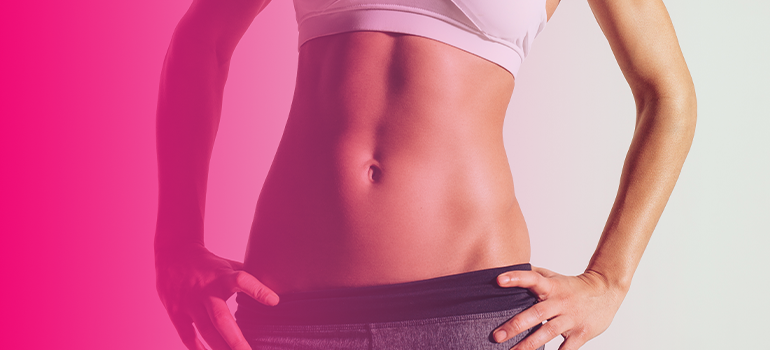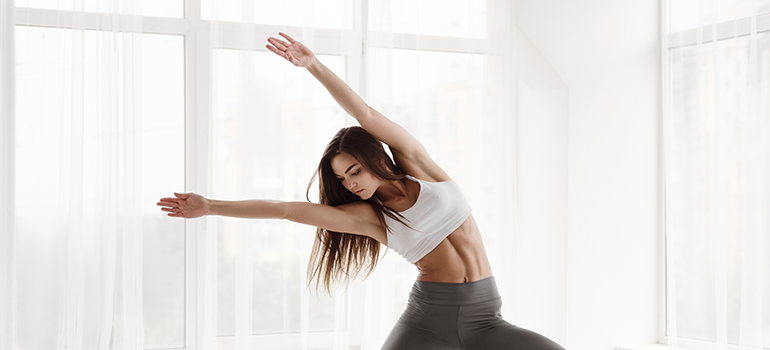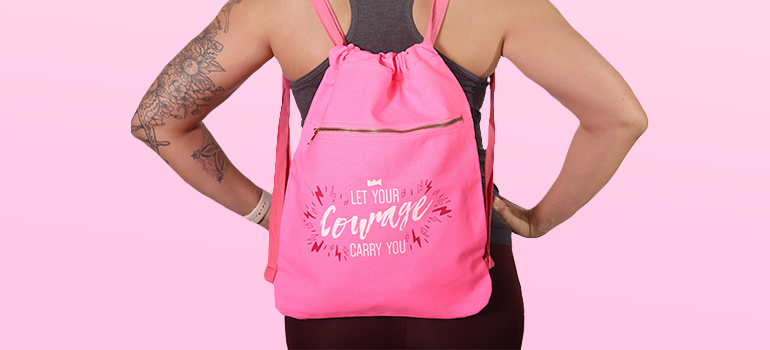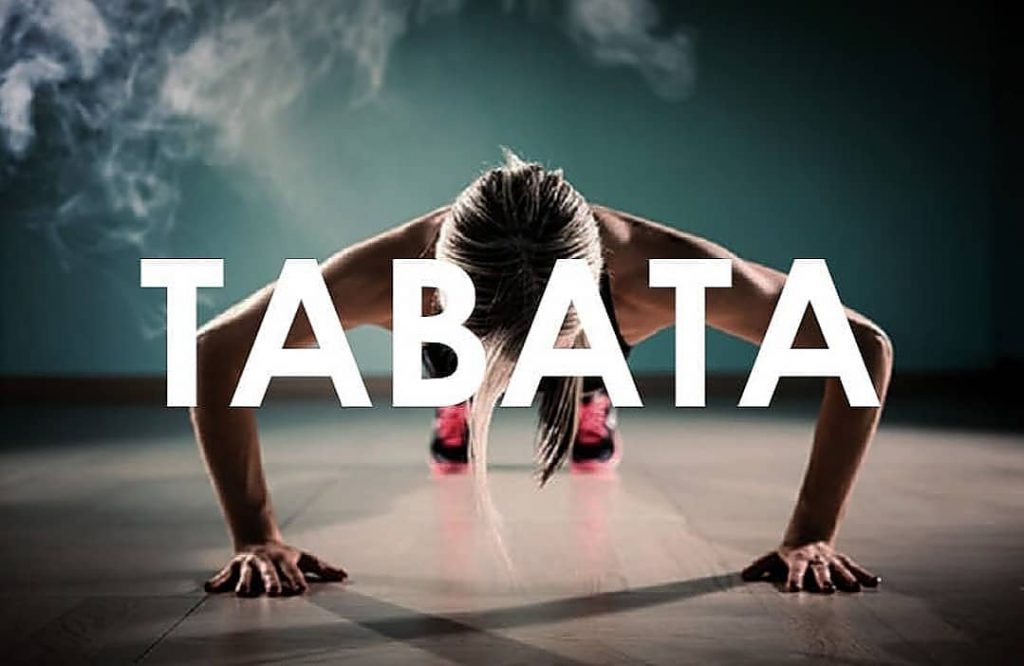I know you want abs. We all do.
Every client that I’ve ever worked with has had abs on their wishlist.
Now, come here. Closer. I’ve got a secret for ya…
You’ve got abs.
Yes. You do. Hear me out…
You’ve probably never thought about it this way, but it took you 10 to 14 months to develop the coordination and strength you needed to overcome gravity and hold your body upright. Yep. I’m talking about walking.
Bet you never thought about the role your abs play in something so basic.
Can you hold yourself upright? Abs! Are you able to stand? Abs! If you can walk, then sweetheart, you’ve got yourself some abs!
Now, where are they? Let’s learn!
Abdominal Anatomy
The abs are much more than just the famous six-pack. (By the way, have you ever recognized that Arnold Schwarzenegger only had a four-pack?? Google it!) You’ve got four abdominal layers in total. From the outside in, you’ve got:
- External obliques (EO) – the largest and outermost layer
- Rectus Abdominis (RA) – the “six-pack”
- Internal Obliques (IA) – the functional opposite of the externals
- Transversus Abdominis (TVA) – the Spanx of the bunch
Check out the illustration below!
 You may be wondering what all of the white stuff is. The white stuff is called fascia. (Sounds like fash-uh.) It’s connective tissue that connects muscles and wraps it up nicely. You’ll see below how all of the layers of the abdominals connect into the fascial sheath of the Rectus Abdominis. The white stripe down the center that splits the six-pack is called the linea alba. It literally means “white line.”
You may be wondering what all of the white stuff is. The white stuff is called fascia. (Sounds like fash-uh.) It’s connective tissue that connects muscles and wraps it up nicely. You’ll see below how all of the layers of the abdominals connect into the fascial sheath of the Rectus Abdominis. The white stripe down the center that splits the six-pack is called the linea alba. It literally means “white line.”
 Now, this is no anatomy class. So, we don’t care where the muscles attach, right?
Now, this is no anatomy class. So, we don’t care where the muscles attach, right?
Wrong! Where the muscles originate and attach tells us exactly how flexing them will move the body and what we’ve got to focus on in our ab exercises for effective abdominal training!
| Muscle | Attachments | Functions |
| External Obliques | From the sides of ribs → to the top of the hip bone, linea alba, and the fascial sheath of the RA; fibers run downward to center | Flexing forward, lateral flexion, and rotation |
| Internal Obliques | From the top of the hip bone → to the ribs, linea alba, and the fascial sheath of the RA; fiber run upward to center | Flexing forward, lateral flexion, and rotation |
| Rectus Abdominis | From the bottom of the sternum → to the pubic bone; fibers run up and down | Flexing forward |
| Transversus Abdominis | From the hip bone and the ribs → to the linea alba and the fascial sheath of the RA; fibers run horizontally | Compression and stability |
 Can you see how all of the abdominal layers are connected between the ribs and the hips & pelvis? That means that every time we’re doing ab workouts, we’re focused on the quality of movement between the hips and the ribs. Don’t forget that, now.
Can you see how all of the abdominal layers are connected between the ribs and the hips & pelvis? That means that every time we’re doing ab workouts, we’re focused on the quality of movement between the hips and the ribs. Don’t forget that, now.
In the ab exercises below, you’ll see that when we move in forward flexion, we pull the pubic bone and the sternum toward each other. In lateral flexion, you pull the side of your ribs and the top of the hip toward each other on the same side. And in rotation, you pull the side of the ribs toward the top of the hip of the opposite side. Effective and comprehensive abdominal workouts include all three motions.
Ab Myths
The misconceptions and the plain bad information out there about ab workouts abound. Let’s take a quick look at a few of the common ab myths:
MYTH #1 – Focus on ab exercises to get a flat stomach.
Sigh. This myth is perpetuated throughout Pinterest, YouTube, and blog articles across the web. Posts with titles like “Ab Exercises to Lose Belly Fat NOW” and “Fast Flat Stomach Workout,” are misleading at best.
This myth is rooted in the idea that the muscles you train the hardest, such as abs, will lose fat the quickest. Unfortunately, we cannot spot treat fat loss. Our genetics and other factors decide where we lose and gain that stuff.
The only way to lose fat is through calorie-deficit—you have to burn more calories through cardio exercise and strength training than you consume.
LadyBoss® has great resources if you want more guidance in your overall exercise programming and nutrition. The LadyBoss® Pocket Personal Trainer contains hundreds of exercises and recipes!
MYTH #2 – Anyone can have a six-pack with hard work.
I don’t mean to be a dream-crusher, but the coveted six-pack isn’t physiologically possible for everyone. We’re all built differently. As said above, genetics and other factors such as age, gender, hormones, stress levels, sleep quality, and more affect where you’ll store fat.
And pregnancies will play a large role in the aesthetic of your midsection. Growing a little human inside of you (an incredible feat that you probably don’t regret!) will stretch your skin. That is something that doesn’t bounce back with ab work. Nothing short of plastic surgery will eliminate sagging skin.
But you are so much more than the look of your abs! We can love and treasure our bellies for what they are and what they do, regardless of whether they can produce a six-pack.
MYTH #3 – Ab muscles are different than other muscles.
Here’s a bit of exercise science for you (woo hoo!): our bodies are composed of two main categories of muscle fibers:
- Slow-twitch (Type I) – Highly-resistant to fatigue, used for posture and endurance, don’t generate a lot of force. Think of these as your supporters.
- Fast-twitch (Type II) – Can generate a large amount of force, but are quick to fatigue; responsible for the size and definition of muscles. Think of these as your movers.
The research is murky on what ratio of muscle fibers each of the abdominal layers contains. One thing is for certain, though: your abs contain both slow-twitch and fast-twitch muscle fibers just like about every other muscle in your body. As such, there’s no reason to treat them any differently.
The rectus abdominis and the abdominal obliques are primarily movers, while the transversus abdominis is a stabilizer and supporter. Understanding this, many trainers will classify the rectus abdominis (RA) and the obliques as fast-twitch and the transversus abdominis (TVA) as slow-twitch.
MYTH #4 – Ab muscles should be worked every day.
As the abdominals are no different than most muscles, the notion that they should be trained differently is flawed.
Your abdominal muscles need rest and recovery just like your biceps, triceps, quads, hamstrings, etc. So, if you’re hitting the abs hard, make sure to get a rest day in between. And, remember that different movements will target different aspects of your abs. Make sure you check out the ab exercises below!
Regardless of what exercises you do, your abs will always play a role in keeping you supported, particularly the TVA.
MYTH #5 – Ab work requires a lot of reps.
Nope. If you’ve got to do a bazillion crunches before you feel anything, that’s an indication that your form needs some switching up to improve the quality of your movement. Actively engage those abdominal layers by drawing your ribs and pelvis/hips together, right where your ab muscles attach as demonstrated in the table above. Otherwise, going through the motions just wastes your time.
And you should feel a burn. Just as with every other strength training exercise, you’ve got to exhaust the muscles — this is called the overload principle — in order for the training to be beneficial.
The illustration below provides an excellent visual of how you engage your abdominals by pulling the bottom of your ribs and your pubic bone toward each other. When you’re working your abs lying on your back on the floor, this will make it so that there is no space between the floor and your back. As a LadyBoss® Personal Results Coach, I like to tell my clients to lift their tailbone up to the ceiling and fold under the ribcage. (Look into Coaching for personalized abdominal training!)
 MYTH #6 – Core and abs are synonymous.
MYTH #6 – Core and abs are synonymous.
Your core actually includes all of the muscles in your trunk, including your pelvic floor and your back. The abs are just the guys in the front.
MYTH #7 – The best ab work takes place on the floor.
False!!! Many of the prevailing ab workouts take place on the floor. However, many exercise physiologists will tell you that the most effective and most functional way to train your abdominals is in an upright position, as you’ll see in many of the ab exercises below. Are you lying on the floor and doing crunching motions in your daily life?
No. You’re a busy woman who runs around conquering the world.
Ab Exercises
Now, let’s get to it! Here are the very best ab workouts for women like you!
For a really quick ab workout that’s effective and requires nothing but your capable body, repeat the following exercises for two or three sets.

- Basic Ab Crunch
I just said that the most functional ab exercises are done in an upright position. I still stand by this. The basic crunch, however, is a great way to get familiar with those ab muscles as you work against gravity to lift your upper body off the floor. This creates great abdominal activation.
The Movement- Begin by lying on your back with your knees bent and feet flat on the floor hip-width apart. Your elbows will be bent with your hands supporting the weight of your head.
- Keeping your elbows wide and your chin slightly tilted down, lift your head, neck, and shoulder blades away from the floor.
- Slowly lower back down to the starting position.
- Repeat 12 to 15 times. (See the myths above if you’re still feeling like you need to do a bazillion crunches.)
* If you want more from your crunches, consider holding a weight or a medicine ball against your chest. Weighted ab exercises capitalize on the overload principle mentioned above.

- Side-Lying Crunch
Now, find those obliques! Lying on your side, working against gravity is a sure-fire way to find and strengthen those muscles.
The Movement- Begin by lying on your right side with legs stacked on top of one another and knees bent. Bend our elbows with your hands supporting the weight of your head.
- Keep your elbows wide and your chin slightly tilted down, lift your head, neck, and shoulder blades away from the floor as high as you can.
- Slowly lower back down to the starting position.
- Repeat 12 to 15 times on both your right and left side.
* To protect your back while working in a rotated position, be sure you engage deep within your abdominals to support and stabilize your spine.

- Standing Crunches
Because standing ab exercises require more stability and coordination, they work more muscles and burn more calories. Woot woot!
The Movement- Stand tall with your elbows bent, fingertips gently touching the back of your head.
- Lift your right knee toward your chest and crunch forward with your torso.
- Set your foot back down and lengthen up through your spine.
- Repeat the same movement lifting your left knee
- Alternate knees for one minute.
* Make sure you’re pulling your belly button in towards your spine to keep your abdominals engaged. The hip flexors should assist as you lift your knees, but not do all of the work.

- Standing Oblique Crunches
Work that muffin top! Alternating movements of lengthening and crunching from one side to another works the obliques in a full range of motion.
The Movement- Stand tall with your elbows bent, fingertips gently touching the back of your head, keeping your elbows wide.
- Lift your right knee toward your right elbow and crunch sideways with your torso.
- Set your foot back down and lengthen up through your spine.
- Repeat the same movement lifting your left knee.
- Alternate for one minute.
* Instead of thinking about pulling your elbow to your knee, think of pulling your side ribs down to the top of your hip. That is where the abdominal activation comes in.

- Standing Oblique Twists
Again, this exercise works your obliques in a full range of motion, but this time in alternating rotations. The Movement- Stand tall with your elbows bent, fingertips gently touching the back of your head, keeping your elbows wide.
- Lift your right knee toward your chest while rotating your rib cage toward the right.
- Set your foot back down and return your spine back to center.
- Repeat the same movement lifting your left knee.
- Alternate for one minute.
* Instead of thinking about pulling your elbow toward your knee, think of pulling one side of your ribcage to the opposite hip. That is where the abdominal activation comes in. I like to tell my clients to twist like a Barbie doll, right across the waistline.

- Plank
A core classic, the plank works your abdominals isometrically, meaning you’re holding and supporting the muscular contraction rather than moving. As this is a stabilizing exercise rather than a moving exercise, many trainers agree that planks are appropriate for daily training. Planks also are functional because they work your abdominals in a lengthened position, similar to an upright position.
The Movement- Come down onto your forearms and knees, making sure that your shoulders are right over your elbows.
- From there, lengthen your legs out long. (For a modification, keep your knees on the ground.)
- Your body should be one long line from the top of your head, to your ribs, to your hips, down on to your feet.
- Don’t hold your breath! Maintain a continuous flow of air in and out.
- Begin by holding the plank for 20 seconds. If you can hold longer without sacrificing your form, by all means, hold it as long as you can! (The world record for the longest plank held by a woman is 4 hours and 20 minutes!!!
* Planks should never hurt your back. This generally tends to happen if abs are not appropriately engaged and the belly sags, excessively curving the spine. Tilt your pelvis, drawing your pubic bone towards your sternum. Think of a bad dog tucking his tail.

- T-Plank with Rotation
Adding some rotation onto the plank, this exercise further challenges your abdominals by taking away a base of support and adding motion. No shame if you fall out of it a time or two. We all have.
The Movement- Begin in a plank with your arms straight, hands directly below your shoulders, lengthening from the top of your head through your ribs, hips, knees, out through the heels.
- With control, move into a side plank by shifting your weight onto your right arm, opening up your chest and your hips to the left and reach your left arm toward the sky. Simultaneously, your feet will shift onto their sides to accommodate the movement of your body. Your top leg will always be in front.
- Maintaining your side plank, you will rotate your torso down toward the floor tucking your left arm in toward your chest.
- Lift back up to your side plank, lengthening your left arm again to the sky.
- With control, shift back to your starting plank position. This completes one rep.
- Repeat on the other side.
- Alternate from side to side completing 10 to 12 reps total.
* Take this slowly! For more support and stability, keep your legs wider than your hips.
Conclusion
For many, many more exercises just like these check out the LadyBoss® Pocket Personal Trainer for free! The Trainer contains an entire section devoted to abs. We know that strong abs are the foundation for a strong body and overall weight loss.
If I can leave you with anything, I want you to know that you have incredible abs whether or not they are visible under your skin. They’re there. Always supporting you. Now show them some love and make them work!


